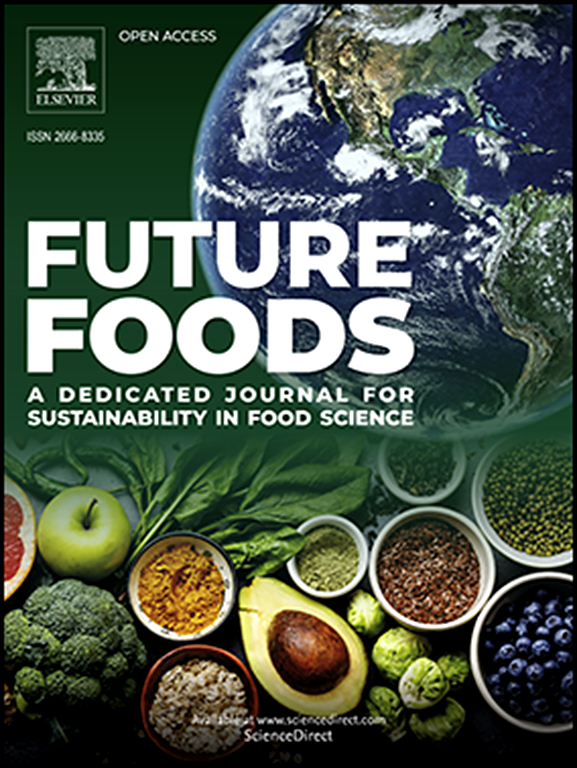利用近红外光谱快速、同步地预测完整芒果的内部质量参数:光谱预处理对预测准确性的影响
IF 7.2
Q1 FOOD SCIENCE & TECHNOLOGY
引用次数: 0
摘要
近红外光谱(NIRS)已被广泛应用于包括农业在内的许多领域,特别是农产品的分类和分级。光谱预处理是影响近红外光谱仪模型准确性和预测能力的主要因素之一。本研究的目的是研究不同光谱校正(即平均居中(MC)、平均归一化(MN)、去趋势(DT)、乘法散度校正(MSC)、标准正态变异(SNV)和正交信号校正(OSC))对完整芒果中可滴定酸度(TA)和可溶性固形物含量(SSC)等质量参数预测准确性的影响。共使用了 91 个芒果样品(品种:肯特)作为校准和外部预测的数据集,这些数据集是通过基于属性的系统取样(SSBP)方法分离出来的。利用 Antaris 傅立叶变换近红外仪器采集并记录了波长范围为 1000 - 2500 nm 的漫反射光谱(log1/R)。从校准和预测性能来看,MSC 是建立预测模型前的最佳光谱预处理方法,对 TA 的 R2 预测值为 0.72,对 SSC 的 R2 预测值为 0.76。虽然与基线相比,基于 R2、RMSE、RPD 和 RER 指标,MSC 提高了预测性能,但这一研究结果的 RPD(TA 为 1.9,SSC 为 1.8)仍然较差,需要改进才能达到实时应用所需的更高准确度和可靠性。本文章由计算机程序翻译,如有差异,请以英文原文为准。
Fast and simultaneous prediction of inner quality parameters on intact mangos by near infrared spectroscopy: Impact of spectra pre-processing on prediction accuracy
Near infrared spectroscopy or known as NIRS has been widely employed in many fields including agriculture, especially for sorting and grading of agricultural products. Spectra pre-processing is one of the main factors affecting model accuracy and prediction capabilities of NIRS. The objective of the present study was to study the impact of different spectra corrections namely mean centering (MC), mean normalization (MN), de-trending (DT), multiplicative scatter correction (MSC), standard normal variate (SNV) and orthogonal signal correction (OSC), to the prediction accuracy of quality parameters: titratable acidity (TA) and soluble solids content (SSC) in intact mango. A total of 91 mango samples (cv. Kent) were used as dataset for calibration and external prediction which was separated by means of systematic sampling based on a property (SSBP) approach. Diffuse reflectance spectra (log1/R) were acquired and recorded in wavelength range of 1000 – 2500 nm by Antaris Fourier transform NIR instrument. Judging from calibration and prediction performance, MSC found to be the best spectra pre-processing method prior to prediction model development with R2 prediction are 0.72 for TA and 0.76 for SSC. Although MSC increase the prediction performances based on R2, RMSE, RPD and RER metrics compared to the baseline, the achieved RPD, 1.9 for TA and 1.8 for SSC of this findings are still poor and need improvements to achieve even higher levels of accuracy and reliability necessitates for real-time applications.
求助全文
通过发布文献求助,成功后即可免费获取论文全文。
去求助
来源期刊

Future Foods
Agricultural and Biological Sciences-Food Science
CiteScore
8.60
自引率
0.00%
发文量
97
审稿时长
15 weeks
期刊介绍:
Future Foods is a specialized journal that is dedicated to tackling the challenges posed by climate change and the need for sustainability in the realm of food production. The journal recognizes the imperative to transform current food manufacturing and consumption practices to meet the dietary needs of a burgeoning global population while simultaneously curbing environmental degradation.
The mission of Future Foods is to disseminate research that aligns with the goal of fostering the development of innovative technologies and alternative food sources to establish more sustainable food systems. The journal is committed to publishing high-quality, peer-reviewed articles that contribute to the advancement of sustainable food practices.
Abstracting and indexing:
Scopus
Directory of Open Access Journals (DOAJ)
Emerging Sources Citation Index (ESCI)
SCImago Journal Rank (SJR)
SNIP
 求助内容:
求助内容: 应助结果提醒方式:
应助结果提醒方式:


